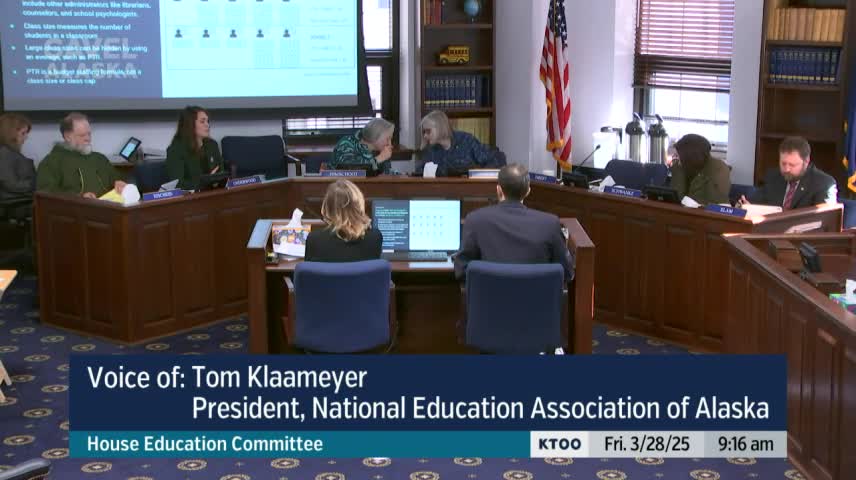Alaska education advocates push for HB 98 to reduce K-12 classroom overcrowding
March 28, 2025 | 2025 Legislature Alaska, Alaska
This article was created by AI summarizing key points discussed. AI makes mistakes, so for full details and context, please refer to the video of the full meeting. Please report any errors so we can fix them. Report an error »

The Alaska Legislature's House Education Committee convened on March 28, 2025, to discuss critical issues surrounding education funding and class sizes in the state. The meeting highlighted the need for adequate funding and potential caps on class sizes to ensure that every student receives the individual attention they deserve.
Testimony from various stakeholders emphasized that while increased funding through the Base Student Allocation (BSA) is essential, it alone may not guarantee smaller class sizes. Mr. Klaymeier, a key testifier, pointed out that a significant portion of school district budgets is allocated to staffing, which complicates the ability to reduce class sizes. He argued that without legislative action to allow local bargaining units to negotiate class sizes, districts may struggle to prioritize smaller classes amidst budget constraints.
The discussion also referenced a 1977 Alaska Supreme Court ruling, known as the Kenai case, which currently prohibits local bargaining units from negotiating class sizes and caseloads. Klaymeier suggested that allowing such negotiations could provide a more cost-effective solution than imposing statewide caps.
Representative Schwanke raised concerns about the trustworthiness of districts to allocate additional funding towards reducing class sizes. Klaymeier responded by explaining that budgetary pressures often lead districts to make cuts in areas other than staffing, which can inadvertently increase class sizes.
Further testimony from Mr. Michael Bronson of the NAACP Education Committee underscored the urgency of addressing overcrowded classrooms. He presented data indicating that many students enter school unprepared and struggle to meet state standards in large classes. Bronson advocated for smaller class sizes as a means to improve educational outcomes and compliance with state educational mandates.
The committee's discussions reflect a growing recognition of the challenges facing Alaska's education system, particularly regarding class sizes and the allocation of resources. As the legislature considers potential reforms, the emphasis remains on creating a sustainable and effective learning environment for all students in Alaska. The next steps will involve further deliberation on proposed legislation aimed at addressing these pressing issues.
Testimony from various stakeholders emphasized that while increased funding through the Base Student Allocation (BSA) is essential, it alone may not guarantee smaller class sizes. Mr. Klaymeier, a key testifier, pointed out that a significant portion of school district budgets is allocated to staffing, which complicates the ability to reduce class sizes. He argued that without legislative action to allow local bargaining units to negotiate class sizes, districts may struggle to prioritize smaller classes amidst budget constraints.
The discussion also referenced a 1977 Alaska Supreme Court ruling, known as the Kenai case, which currently prohibits local bargaining units from negotiating class sizes and caseloads. Klaymeier suggested that allowing such negotiations could provide a more cost-effective solution than imposing statewide caps.
Representative Schwanke raised concerns about the trustworthiness of districts to allocate additional funding towards reducing class sizes. Klaymeier responded by explaining that budgetary pressures often lead districts to make cuts in areas other than staffing, which can inadvertently increase class sizes.
Further testimony from Mr. Michael Bronson of the NAACP Education Committee underscored the urgency of addressing overcrowded classrooms. He presented data indicating that many students enter school unprepared and struggle to meet state standards in large classes. Bronson advocated for smaller class sizes as a means to improve educational outcomes and compliance with state educational mandates.
The committee's discussions reflect a growing recognition of the challenges facing Alaska's education system, particularly regarding class sizes and the allocation of resources. As the legislature considers potential reforms, the emphasis remains on creating a sustainable and effective learning environment for all students in Alaska. The next steps will involve further deliberation on proposed legislation aimed at addressing these pressing issues.
View full meeting
This article is based on a recent meeting—watch the full video and explore the complete transcript for deeper insights into the discussion.
View full meeting
